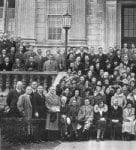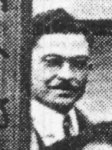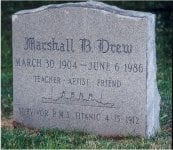Marshall Brines Drew was born in Greenport, Suffolk, New York on 30 March 1904. He was the son of William John Drew (b. 1864) and Annie Eliza Brines (b. 1871).
Marshall's father was English, hailing from Constantine, Cornwall, whilst his mother was born in Woonsocket, Rhode Island to English parents. His father had emigrated to the USA around 1886 and operated a successful marble monument business with his younger brother James Vivian Drew (b. 1869). He had been married on 20 April 1893 in Massachusetts to Louisa Jenkins (b. 1866), also from Constantine, Cornwall. The couple had a son named William Lewis (b. 14 January 1894) but Louisa died the same year, presumably from complications of childbirth, and upon her death she was buried in River Bend Cemetery, Westerly, Rhode Island. William would later lose his son William at age four on 13 March 1898.
William was remarried in Providence, Rhode Island on 24 June 1903 to Annie Eliza Brines, a former cotton spooler. Their son Marshall was born nine months later but Annie survived less than a few weeks following the birth of her son. William, unable to care properly for his son himself, delegated that responsibility to his childless brother James and his wife Lulu. Young Marshall grew up in Southold, New York and appeared there on the 1910 census with his aunt and uncle and his father. He would call his aunt Lulu "mother."
James, his wife and Marshall travelled on the Olympic in the autumn of 1911 for a holiday to visit his relatives in Constantine, Cornwall. Their return journey to America was on board the Titanic which they boarded at Southampton as second class passengers (ticket number 28220 which cost £32, 10s). It is possible that they travelled with James Veal who was also a native of Constantine. On embarking James and Marshall were able to view the first-class areas including the gymnasium and the barber's shop.
On the night of the sinking James had been up on deck whilst his wife and nephew were settled in their cabin. Following the impact with the iceberg, James returned to the cabin, instructing them to dress and put on their lifebelts. He escorted Lulu and Marshall to a lifeboat, bid them goodbye and stepped back into the crowd.
Marshall recalled a perilous drop to the ocean in his lifeboat, with the pulleys jamming, causing the lifeboat to drop suddenly at one end on a few occasions. He also described the Titanic listing right out of the ocean, with the sounds of heavy machinery crashing towards her bows, the sight of people falling from her decks and the sounds of those people struggling in the freezing water.
He fell asleep in his lifeboat to awaken to the sight of dozens of icebergs for miles around and soon saw the Carpathia steaming-in to their rescue. He also recollected his excitement at scaling the side of their rescue vessel, a feat many others seemed to fear. Upon his arrival in New York he was met by his father who was prostrated with anxiety at the thought of the loss of his son.
Marshall returned to Southold, New York with his aunt Lulu and his father. He would lose his father to tuberculosis in 1917 and aunt Lulu remarried, becoming Mrs Richard Opie. He was still living with his aunt in Southold by the time of the 1920 census but soon went to live with Lulu's parents, the Christians.
Gifted with an artistic flair, Marshall became a graduate of Pratt Institute in New York in 1928 and attended Columbia University, later becoming a teacher, specialising in art, and teaching in Brooklyn public schools until his retirement. He was married to a Connecticut-born woman named Mary (b. 1912) and they had a daughter, Bette Elizabeth (later Wible), on 27 March 1937. The family are shown on the 1940 census living in Queens, New York and Marshall is described as a teacher. Following retirement, he continued to teach art and host art events and was a talented photographer of natural life and an expert in origami.


Marshall Drew at Grover Cleveland High School
Clevelkand Log Yearbook 1939. Photo: Liz Reitz
He gave countless interviews about his experiences on Titanic and befriended many Titanic enthusiasts over the years. Held in high esteem by all he knew him, he was distinctive in appearance for his flowing white hair and his craggy face. In later years he relocated from New York to Dunns Corner, Westerly, Rhode Island where he continued to teach and live up until his death.
Marshall died on 6 June 1986 aged 82. He is buried in River Bend Cemetery, Westerly, Rhode Island and on his headstone is a depiction of the Titanic. The inscription reads 'Teacher, Artist, Friend - Survivor of the Titanic Disaster 15 April 1912.'





Comment and discuss